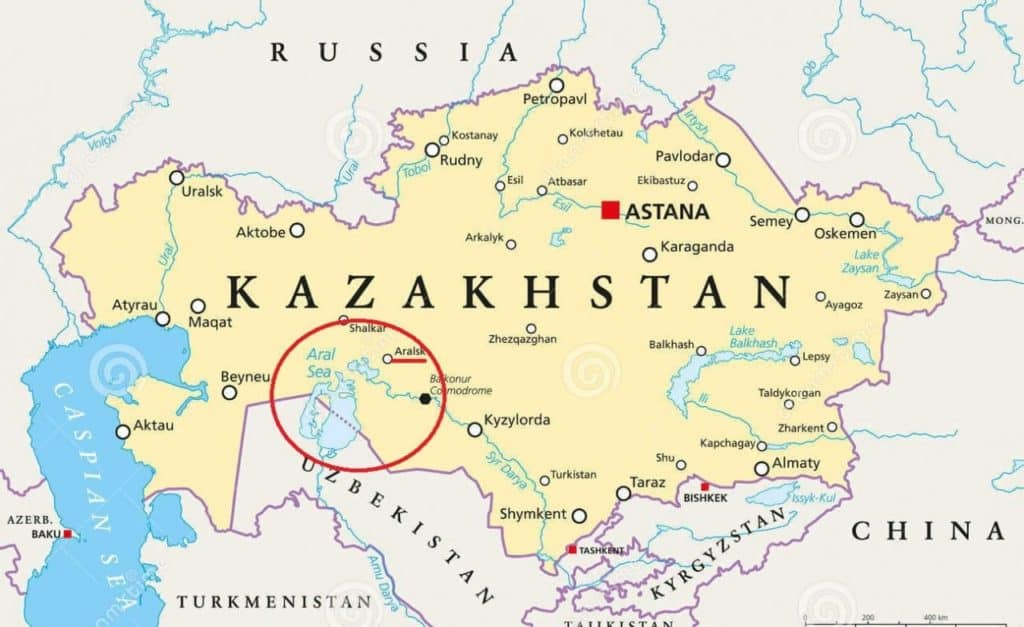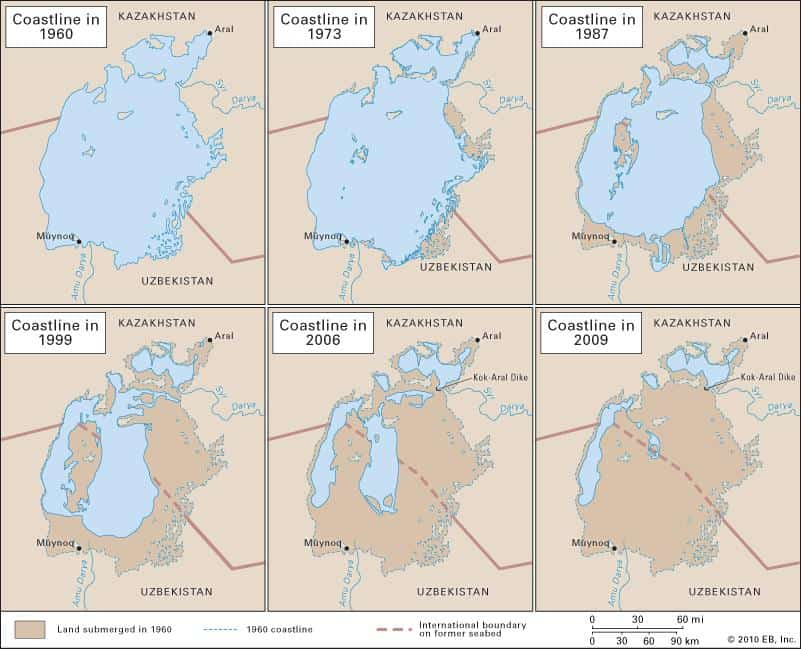Description

Copyright infringement not intended
Picture Courtesy: https://www.journalofnomads.com/aral-sea-ship-graveyard/
Context: The Aral Sea was once one of the largest inland water bodies but has shrunk to less than a quarter of its former size.
Details
- The Aral Sea, which lies between Kazakhstan and Uzbekistan, was once one of the world's largest inland bodies of water but has shrunk to less than a quarter of its original size due to human engineering and agricultural projects, as well as climate change.
- Human engineering and agricultural projects, compounded by the effects of climate change, have played a pivotal role in the sea's shrinkage, disrupting the delicate balance of its ecosystem.
- Local communities around the Aral Sea face severe consequences, with collapsed fisheries impacting livelihoods, agricultural lands turning unproductive due to increased salinity and escalating poverty and food insecurity.
How did the Aral Sea disappear?
- River Diversion: In the 1960s, the Soviet Union diverted the inflow of the Syr Darya and Amu Darya rivers, which were the primary water sources feeding the Aral Sea, for irrigation purposes, aimed to transform the arid plains of Kazakhstan, Uzbekistan, and Turkmenistan into farms for cotton and other crops. This diversion significantly reduced the water supply to the sea.
- Rapid Decline in Water Levels: As a consequence of reduced inflow, the water level of the Aral Sea began to drop rapidly, leading to the exposure of vast areas of the former seabed.
- Formation of Multiple Basins: By 1987, the sea had split into two distinct parts: the northern and southern seas. Subsequently, the southern sea was further divided into eastern and western basins by 2003.
- Complete Drying of Eastern Basin: The eastern basin of the southern sea dried up completely by 2014, leaving behind a salt desert due to the continued decline in water levels and increased salinity.
- Shrinkage of Western Basin: The western basin of the southern sea also experienced significant shrinkage, further contributing to the overall decline in the size of the Aral Sea.

How does climate change affect the Aral Sea?
- Increased Evaporation Rate: Climate change has led to an acceleration in the disappearance of the Aral Sea by increasing its evaporation rate. Higher temperatures contribute to more rapid evaporation of the remaining water in the sea.
- Reduced Precipitation and Runoff: Climate change has altered precipitation patterns and reduced runoff in the region, further diminishing the inflow of water into the Aral Sea. This reduction in water supply intensifies the sea's shrinkage.
- Temperature Rise in Central Asia: The average temperature in Central Asia has increased by 1.5 degrees Celsius since 1950. Projections indicate a further rise of 3 to 5 degrees by 2050. Elevated temperatures contribute to increased evaporation and worsen water scarcity in the region.
- Glacial Retreat: Climate change impacts the glaciers that feed the rivers flowing into the Aral Sea. Since 1960, these glaciers have lost approximately 27% of their mass, and projections suggest an additional 50% loss by 2050. This glacial retreat reduces the water availability for both irrigation and replenishing the Aral Sea.
- Water Availability Challenges: The combined effects of increased evaporation, reduced precipitation, and glacial retreat pose significant challenges to water availability for the Aral Sea region. This affects ecosystems, agriculture, and the overall sustainability of the surrounding communities.
What are the impacts of the Aral Sea's disappearance?
- Loss of Fisheries and Livelihoods: The collapse of fish stocks due to the shrinking Aral Sea has led to the loss of a once-thriving fishing industry, resulting in unemployment for about 60,000 people. Fishing villages have turned into ghost towns, and many residents have migrated to seek employment elsewhere.
- Land Degradation and Desertification: The exposed seabed has become a source of toxic dust storms carrying salt, pesticides, and heavy metals. These dust storms adversely affect soil quality, reduce crop yields, and pose health risks to the population, contributing to land degradation and desertification.
- Water Scarcity and Pollution: Water diversion for irrigation has diminished the availability and quality of water for drinking and domestic use in the region. Contamination of the remaining water with salt, chemicals, and pathogens poses serious health risks for both humans and animals.
- Health Problems: The population around the Aral Sea faces various health issues linked to water pollution, dust exposure, malnutrition, and infectious diseases. Health problems include respiratory infections, kidney stones, liver damage, eye irritation, skin diseases, cancer, anaemia, birth defects, and infant mortality.
- Biodiversity Loss: The shrinking Aral Sea has resulted in the loss of habitats and food sources for diverse flora and fauna. Several species, including the Aral salmon, Aral seal, and various bird species, have faced extinction or endangerment.
- Water-Related Conflicts: Reduced water availability has increased the risk of conflicts over water resources among different users and countries in the region.
- Global Environmental Impact: The environmental degradation around the Aral Sea contributes to global warming by reducing the land surface's reflectivity (albedo) and increasing greenhouse gas emissions from decomposing organic matter.

What can be done to save the Aral Sea?
- Improving Water Management: Implementing efficient water management practices is crucial to reducing the excessive diversion of water from the rivers that feed the Aral Sea. Measures such as promoting water-saving irrigation techniques, implementing water metering and pricing systems, and enforcing water conservation policies can help mitigate the water crisis in the region.
- Promoting Sustainable Agriculture: Encouraging sustainable agricultural practices that require less water, such as crop diversification, soil conservation, and agroforestry, can help reduce the pressure on water resources and prevent further depletion of the Aral Sea.
- Investing in Alternative Livelihoods: Diversifying local economies away from water-intensive activities like cotton farming towards more sustainable livelihoods such as eco-tourism, fisheries, and small-scale agriculture can help alleviate poverty while reducing the strain on water resources.
- Restoring Ecosystems: Rehabilitating degraded ecosystems around the Aral Sea, such as wetlands and riparian habitats, can help improve water quality, enhance biodiversity, and restore the natural balance of the region.
- International Cooperation: Strengthening regional cooperation among the countries sharing the Aral Sea basin is essential for addressing transboundary water issues and implementing coordinated strategies for water management and conservation.
- Mitigating Climate Change: Addressing the root causes of climate change through reducing greenhouse gas emissions, transitioning to renewable energy sources, and implementing climate adaptation measures is crucial for preventing further degradation of the Aral Sea ecosystem.
- Public Awareness and Education: Raising awareness among local communities, policymakers, and the public about the importance of preserving the Aral Sea and its ecosystems can foster a sense of stewardship and collective action towards its conservation.
Conclusion
- The disappearance of the Aral Sea has had devastating consequences for the people and ecosystems around it. A comprehensive and integrated approach that combines water management reforms, sustainable development strategies, ecosystem restoration efforts, and climate change mitigation measures is essential for saving the Aral Sea and ensuring the long-term well-being of the region.
|
PRACTICE QUESTION
Q. While climate change affects everyone, some communities and countries are disproportionately impacted. How to ensure a just and equitable transition to a low-carbon future, addressing historical inequalities and empowering vulnerable populations to adapt?
|













